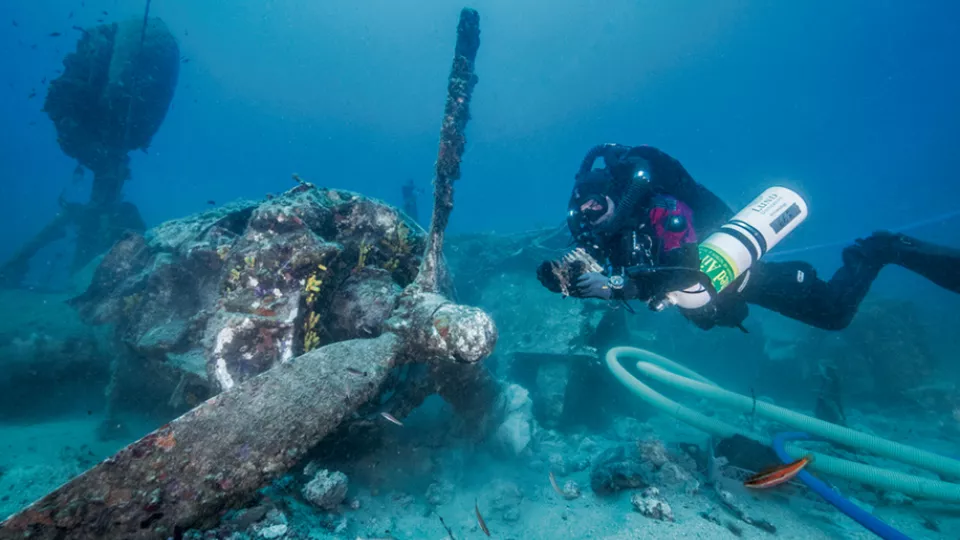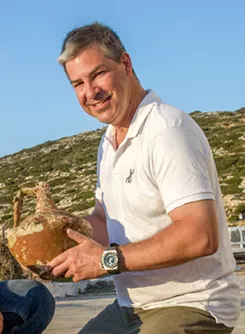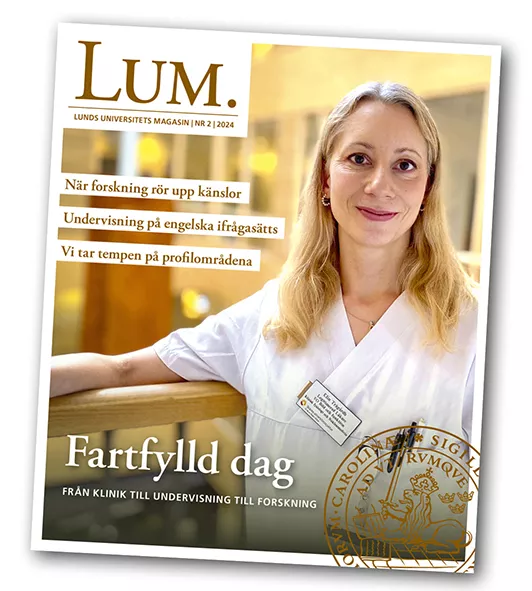"Rest easy, we are here to bring you home, we thought, as we retrieved the remains of the pilot who had lain at a depth of 40 metres for over 70 years", says the marine archaeologist Brendan Foley, a researcher in archaeology at Lund University.
The project was carried out in the summer of 2017 and the marine archaeologists found, among other things, skeletal remains, the pilot's wedding ring and buttons from his uniform. Prior to this, they had contact with Eugene Ford's family, talked with his wife and some of the survivors of the crash.
"We knew who we were looking for. On a personal level, it was a very emotional experience."
The task Brendan Foley was assigned by the United States Armed Forces in 2016 was to dive down to the sea floor and excavate the plane wreck to retrieve any human remains still inside. Via DNA, the US Armed Forces were able to confirm the identification of the soldier who was then given a state funeral at home in the US.
Another of Brendan Foley's big projects is the excavation of a shipwreck off the Greek island of Antikythera. The 2000-year-old Roman ship was discovered by sponge divers in 1900 and is known for its significant artefacts that have spread across the sea floor. They consist of countless amphorae, glass objects, bronze and marble statues and oil lamps. The famous so-called Antikythera mechanism, previously retrieved from the wreck, was described by experts as an analogue computer able to predict astronomical events. The many artefacts found on the sea floor indicate it was a merchant ship.
Brendan Foley negotiated with the Greek authorities for many years before being granted permission for the project he then led together with the Greek Ephorate of Underwater Antiquities.
"Often, an elaborate political dance has to take place before you can get started on excavations. I have the great advantage of feeling comfortable negotiating with politicians, diplomats and financial backers – a skill I was officially trained in during my doctoral studies at MIT", says Brendan Foley.
The technology has developed so much during the 2000s and this, together with a good dose of ingenuity, has been crucial to be able to excavate the ship that is located at a depth of 50 metres and where large parts are located on a steep slope. However, a lot of time is also dedicated afterward to interpreting and analysing the material without destroying it. Brendan Foley says close collaboration between different archaeologists, chemists, biologists, engineers and computer engineers is key, both to be able to carry out the excavations and for the subsequent analyses.
"It leads to completely new ideas and solutions and is wonderful fun, like a giant scientific playground", says Brendan Foley.
During the excavation that began in 2014, the Exosuit diving suit was used for the first time in archaeology – a diving system resembling a Marvel superhero suit. Divers can remain at a depth of 300 metres for many hours, giving divers more time at the bottom than has ever been possible before. Archaeologically groundbreaking methods also included the DNA analysis of residues found within the walls of amphorae, making it possible to find out what had been inside the apparently empty vessels with the help of modern molecular biology techniques.
Expeditions of this size are extremely expensive; Brendan Foley therefore dedicates a significant amount of his working hours to securing funds.
"I do not use volunteers; I only use experts on board the boats to achieve the best possible research results in the shortest period of time. Nobody would suggest a neurosurgeon takes on a volunteer in the operating theatre", says Brendan Foley.
This summer a large excavation awaits, of King John's flagship, Gribshunden, also known as Griffen, that sank in 1495 off Stora Ekön (Great Oak Island) in the Ronneby archipelago. King John was on his way to meet Sten Sture (the Elder) to negotiate the accession to the throne under the Kalmar Union.
"It is extremely exciting given that the ship is the best preserved of its time with this kind of ship construction required by explorers for their expeditions. A similar example of a ship like this is Christopher Colombus' ship, Santa Maria. We also believe we will find weapons given that the ship was probably equipped for battle", concludes Brendan Foley.
GISELA LINDBERG




